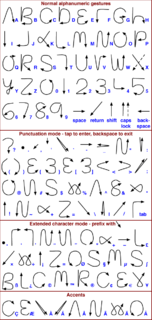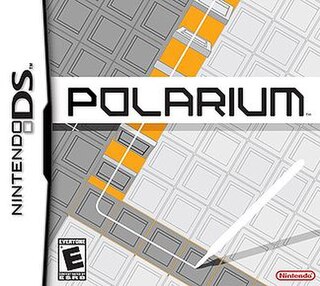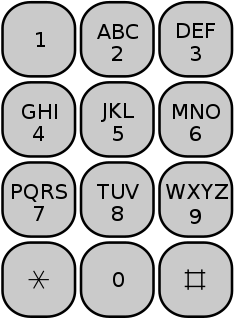
The MessagePad is a discontinued series of personal digital assistant devices developed by Apple Computer for the Newton platform in 1993. Some electronic engineering and the manufacture of Apple's MessagePad devices was undertaken in Japan by Sharp. The devices are based on the ARM 610 RISC processor and all featured handwriting recognition software and were developed and marketed by Apple. The devices run Newton OS.

A personal digital assistant (PDA), also known as a handheld PC, is a variety mobile device which functions as a personal information manager. PDAs have been mostly displaced by the widespread adoption of highly capable smartphones, in particular those based on iOS and Android.

Palm OS was a mobile operating system initially developed by Palm, Inc., for personal digital assistants (PDAs) in 1996. Palm OS was designed for ease of use with a touchscreen-based graphical user interface. It is provided with a suite of basic applications for personal information management. Later versions of the OS have been extended to support smartphones. Several other licensees have manufactured devices powered by Palm OS.

Optical character recognition or optical character reader (OCR) is the electronic or mechanical conversion of images of typed, handwritten or printed text into machine-encoded text, whether from a scanned document, a photo of a document, a scene-photo or from subtitle text superimposed on an image.

Handwriting recognition (HWR), also known as handwritten text recognition (HTR), is the ability of a computer to receive and interpret intelligible handwritten input from sources such as paper documents, photographs, touch-screens and other devices. The image of the written text may be sensed "off line" from a piece of paper by optical scanning or intelligent word recognition. Alternatively, the movements of the pen tip may be sensed "on line", for example by a pen-based computer screen surface, a generally easier task as there are more clues available. A handwriting recognition system handles formatting, performs correct segmentation into characters, and finds the most plausible words.

Graffiti is an essentially single-stroke shorthand handwriting recognition system used in PDAs based on the Palm OS. Graffiti was originally written by Palm, Inc. as the recognition system for GEOS-based devices such as HP's OmniGo 100 and 120 or the Magic Cap-line and was available as an alternate recognition system for the Apple Newton MessagePad, when NewtonOS 1.0 could not recognize handwriting very well. Graffiti also runs on the Windows Mobile platform, where it is called "Block Recognizer", and on the Symbian UIQ platform as the default recognizer and was available for Casio's Zoomer PDA.

A stylus is a writing utensil or a small tool for some other form of marking or shaping, for example, in pottery. It can also be a computer accessory that is used to assist in navigating or providing more precision when using touchscreens. It usually refers to a narrow elongated staff, similar to a modern ballpoint pen. Many styluses are heavily curved to be held more easily. Another widely used writing tool is the stylus used by blind users in conjunction with the slate for punching out the dots in Braille.

An input method is an operating system component or program that enables users to generate characters not natively available on their input devices by using sequences of characters that are natively available on their input devices. Using an input method is usually necessary for languages that have more graphemes than there are keys on the keyboard.

In computing, a zooming user interface or zoomable user interface is a graphical environment where users can change the scale of the viewed area in order to see more detail or less, and browse through different documents. A ZUI is a type of graphical user interface (GUI). Information elements appear directly on an infinite virtual desktop, instead of in windows. Users can pan across the virtual surface in two dimensions and zoom into objects of interest. For example, as you zoom into a text object it may be represented as a small dot, then a thumbnail of a page of text, then a full-sized page and finally a magnified view of the page.

Typing is the process of writing or inputting text by pressing keys on a typewriter, computer keyboard, cell phone, or calculator. It can be distinguished from other means of text input, such as handwriting and speech recognition. Text can be in the form of letters, numbers and other symbols. The world's first typist was Lillian Sholes from Wisconsin, the daughter of Christopher Sholes, who invented the first practical typewriter.

The Tungsten series was Palm, Inc.'s line of business-class Palm OS-based PDAs.
The Samsung SPH-i500 was a Palm OS-based smartphone manufactured by Samsung Electronics. It was previewed at CommunicAsia 2002 in June and launched later that year. It was later discontinued in August 2005. It was marketed in the United States for use on Sprint's mobile phone network.

"Graffiti 2 Powered by Jot" was introduced in 2003 as a revised version of the original Palm OS handwriting system Graffiti. In January 2003, PalmSource announced the change explaining that Graffiti 2 was based on Jot by Communication Intelligence Corporation (CIC) and would replace the original version of Graffiti. Graffiti 2 made its debut in Palm OS 4.1.2 for Motorola DragonBall-based handhelds and in Palm OS Garnet 5.2 for ARM-based ones.

Polarium is a puzzle game developed by Mitchell Corporation for the Nintendo DS. It was a launch title in Japan, Europe and China. In the game, players use a stylus to draw lines on the DS's touch screen, flipping black and white tiles to clear puzzles.
In computer user interfaces, a cursor is an indicator used to show the current position for user interaction on a computer monitor or other display device that will respond to input from a text input or pointing device. The mouse cursor is also called a pointer, owing to its resemblance in usage to a pointing stick.

LetterWise and WordWise were predictive text entry systems developed by Eatoni Ergonomics (Eatoni) for handheld devices with ambiguous keyboards / keypads, typically non-smart traditional cellphones and portable devices with keypads. All patents covering those systems have expired. LetterWise used a prefix based predictive disambiguation method and can be demonstrated to have some advantages over the non-predictive Multi-tap technique that was in widespread use at the time that system was developed. WordWise was not a dictionary-based predictive system, but rather an extension of the LetterWise system to predict whole words from their linguistic components. It was designed to compete with dictionary-based predictive systems such as T9 and iTap which were commonly used with mobile phones with 12-key telephone keypads.

Pen computing refers to any computer user-interface using a pen or stylus and tablet, over input devices such as a keyboard or a mouse.
In electrical engineering, capacitive sensing is a technology, based on capacitive coupling, that can detect and measure anything that is conductive or has a dielectric different from air. Many types of sensors use capacitive sensing, including sensors to detect and measure proximity, pressure, position and displacement, force, humidity, fluid level, and acceleration. Human interface devices based on capacitive sensing, such as touchpads, can replace the computer mouse. Digital audio players, mobile phones, and tablet computers will sometimes use capacitive sensing touchscreens as input devices. Capacitive sensors can also replace mechanical buttons.

The iPhone is the first iPhone model and the first smartphone designed and marketed by Apple Inc. After years of rumors and speculation, it was officially announced on January 9, 2007, and it was released in the United States on June 29, 2007.

The Fossil Wrist PDA is a smartwatch that runs Palm OS. The newer incarnation, which does not include Palm OS, is called the Fossil WristNet watch.
















